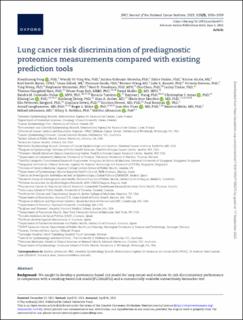| dc.contributor.author | Feng, Xiaoshuang | |
| dc.contributor.author | Wu, Wendy Yi-Ying | |
| dc.contributor.author | Onwuka, Justina Ucheojor | |
| dc.contributor.author | Haider, Zahra | |
| dc.contributor.author | Alcala, Karine | |
| dc.contributor.author | Smith-Byrne, Karl | |
| dc.contributor.author | Zahed, Hana | |
| dc.contributor.author | Guida, Florence | |
| dc.contributor.author | Wang, Renwei | |
| dc.contributor.author | Bassett, Julie K. | |
| dc.contributor.author | Stevens, Victoria | |
| dc.contributor.author | Wang, Ying | |
| dc.contributor.author | Weinstein, Stephanie | |
| dc.contributor.author | Freedman, Neal D. | |
| dc.contributor.author | Chen, Chu | |
| dc.contributor.author | Tinker, Lesley | |
| dc.contributor.author | Nøst, Therese Haugdahl | |
| dc.contributor.author | Koh, Woon-Puay | |
| dc.contributor.author | Muller, David | |
| dc.contributor.author | Colorado-Yohar, Sandra M. | |
| dc.contributor.author | Tumino, Rosario | |
| dc.contributor.author | Hung, Rayjean J. | |
| dc.contributor.author | Amos, Christopher I. | |
| dc.contributor.author | Lin, Xihong | |
| dc.contributor.author | Zhang, Xuehong | |
| dc.contributor.author | Arslan, Alan A. | |
| dc.contributor.author | Sánchez, Maria-Jose | |
| dc.contributor.author | Sørgjerd, Elin Pettersen | |
| dc.contributor.author | Severi, Gianluca | |
| dc.contributor.author | Hveem, Kristian | |
| dc.contributor.author | Brennan, Paul | |
| dc.contributor.author | Langhammer, Arnulf | |
| dc.contributor.author | Milne, Roger L. | |
| dc.contributor.author | Yuan, Jian-Min | |
| dc.contributor.author | Melin, Beatrice | |
| dc.contributor.author | Johansson, Mikael | |
| dc.contributor.author | Robbins, Hilary A. | |
| dc.contributor.author | Johansson, Mattias | |
| dc.date.accessioned | 2023-09-25T08:19:04Z | |
| dc.date.available | 2023-09-25T08:19:04Z | |
| dc.date.created | 2023-09-15T09:41:38Z | |
| dc.date.issued | 2023 | |
| dc.identifier.citation | Journal of the National Cancer Institute. 2023, 115 (9), 1050-1059. | en_US |
| dc.identifier.issn | 0027-8874 | |
| dc.identifier.uri | https://hdl.handle.net/11250/3091638 | |
| dc.description.abstract | Background
We sought to develop a proteomics-based risk model for lung cancer and evaluate its risk-discriminatory performance in comparison with a smoking-based risk model (PLCOm2012) and a commercially available autoantibody biomarker test.
Methods
We designed a case-control study nested in 6 prospective cohorts, including 624 lung cancer participants who donated blood samples at most 3 years prior to lung cancer diagnosis and 624 smoking-matched cancer free participants who were assayed for 302 proteins. We used 470 case-control pairs from 4 cohorts to select proteins and train a protein-based risk model. We subsequently used 154 case-control pairs from 2 cohorts to compare the risk-discriminatory performance of the protein-based model with that of the Early Cancer Detection Test (EarlyCDT)-Lung and the PLCOm2012 model using receiver operating characteristics analysis and by estimating models’ sensitivity. All tests were 2-sided.
Results
The area under the curve for the protein-based risk model in the validation sample was 0.75 (95% confidence interval [CI] = 0.70 to 0.81) compared with 0.64 (95% CI = 0.57 to 0.70) for the PLCOm2012 model (Pdifference = .001). The EarlyCDT-Lung had a sensitivity of 14% (95% CI = 8.2% to 19%) and a specificity of 86% (95% CI = 81% to 92%) for incident lung cancer. At the same specificity of 86%, the sensitivity for the protein-based risk model was estimated at 49% (95% CI = 41% to 57%) and 30% (95% CI = 23% to 37%) for the PLCOm2012 model.
Conclusion
Circulating proteins showed promise in predicting incident lung cancer and outperformed a standard risk prediction model and the commercialized EarlyCDT-Lung. | en_US |
| dc.language.iso | eng | en_US |
| dc.publisher | Oxford University Press | en_US |
| dc.rights | Navngivelse-Ikkekommersiell 4.0 Internasjonal | * |
| dc.rights.uri | http://creativecommons.org/licenses/by-nc/4.0/deed.no | * |
| dc.title | Lung cancer risk discrimination of prediagnostic proteomics measurements compared with existing prediction tools | en_US |
| dc.title.alternative | Lung cancer risk discrimination of prediagnostic proteomics measurements compared with existing prediction tools | en_US |
| dc.type | Peer reviewed | en_US |
| dc.type | Journal article | en_US |
| dc.description.version | publishedVersion | en_US |
| dc.source.pagenumber | 1050-1059 | en_US |
| dc.source.volume | 115 | en_US |
| dc.source.journal | Journal of the National Cancer Institute | en_US |
| dc.source.issue | 9 | en_US |
| dc.identifier.doi | 10.1093/jnci/djad071 | |
| dc.identifier.cristin | 2175357 | |
| cristin.ispublished | true | |
| cristin.fulltext | original | |
| cristin.qualitycode | 2 | |

